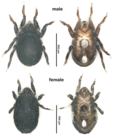WoRMS taxon details
Ameronothrus retweet Pfingstl & Shimano, 2022
1591786 (urn:lsid:marinespecies.org:taxname:1591786)
accepted
Species
marine, terrestrial
Pfingstl, T.; Hiruta, S. F.; Bardel-Kahr, I.; Obae, Y.; Shimano, S. (2022). Another mite species discovered via social media - <i>Ameronothrus retweet</i> sp. nov. (Acari, Oribatida) from Japanese coasts, exhibiting an interesting sexual dimorphism. <em>International Journal of Acarology.</em> 48(4-5): 348-358., available online at https://doi.org/10.1080/01647954.2022.2074538 [details] 
Holotype NMNS NSMT-Ac 14686 (), geounit Sea of Japan
, Note Holotype: adult female (length 844 μm, width...
Holotype NMNS NSMT-Ac 14686 (Holotype), geounit Sea of Japan [details]
From editor or global species database
Type material Holotype: adult female (length 844 μm, width 444 μm); allotype: adult male (length 641 μm, width 363 μm), Japan, Honshu, Tottori prefecture, Tottori City; Fukube, Iwado, Iwado Rock Beach; 31 March 2021, leg. OBAE Yuito. Preserved in ethanol and deposited at the Collection of Arachnida, Department of Zoology, National Museum of Nature and Science, Tokyo (NMST). Four paratypes (2 males, 2 females) from the same sample deposited in the collections of the Senckenberg Museum für Naturkunde Görlitz (SMNG). [details]
Etymology The specific name ‘retweet’ is given as noun in apposition. “Retweet” is used as both a verb and noun on the social...
Etymology The specific name ‘retweet’ is given as noun in apposition. “Retweet” is used as both a verb and noun on the social media application Twitter (twitter Inc.) and means repost or forward a message. The present work does not represent a direct act of retweeting in a strict sense, but the species was discovered by a post as a response to the message about the discovery of A. twitter. [details]
WoRMS (2024). Ameronothrus retweet Pfingstl & Shimano, 2022. Accessed at: https://www.marinespecies.org/aphia.php?p=taxdetails&id=1591786 on 2024-04-29
Date
action
by
![]() The webpage text is licensed under a Creative Commons Attribution 4.0 License
The webpage text is licensed under a Creative Commons Attribution 4.0 License
original description
Pfingstl, T.; Hiruta, S. F.; Bardel-Kahr, I.; Obae, Y.; Shimano, S. (2022). Another mite species discovered via social media - <i>Ameronothrus retweet</i> sp. nov. (Acari, Oribatida) from Japanese coasts, exhibiting an interesting sexual dimorphism. <em>International Journal of Acarology.</em> 48(4-5): 348-358., available online at https://doi.org/10.1080/01647954.2022.2074538 [details] 
 Present
Present  Present in aphia/obis/gbif/idigbio
Present in aphia/obis/gbif/idigbio  Inaccurate
Inaccurate  Introduced: alien
Introduced: alien  Containing type locality
Containing type locality
Holotype NMNS NSMT-Ac 14686 (Holotype), geounit Sea of Japan [details]
From editor or global species database
Diagnosis Differential diagnosis: The colour is dark brown, nearly black. Body length is 641–859 μm. In centrodorsal notogastral cuticle with dense granulation, lateral parts are covered with larger granules. Prodorsal lamellar keels are converging. Short clavate sensilli are present. Interlamellar and exobothridial setae are absent. Labiogenal articulation is complete. One pair of adanal setae located posteriorly of anal orifice. Remarkable sexual dimorphism is present, females with strongly folded gastronotic integument and considerably shorter epimeral, genital, and aggenital setae. Male spermatopositor conspicuously elongated, female ovipositor very short. Primilateral setae pl on tarsus I are present. Dorsal companion seta d on genu I, II, and III and all tibiae are present. Tarsal distal setae end with a small nodule. Juveniles is unknown. [details]Etymology The specific name ‘retweet’ is given as noun in apposition. “Retweet” is used as both a verb and noun on the social media application Twitter (twitter Inc.) and means repost or forward a message. The present work does not represent a direct act of retweeting in a strict sense, but the species was discovered by a post as a response to the message about the discovery of A. twitter. [details]
Type material Holotype: adult female (length 844 μm, width 444 μm); allotype: adult male (length 641 μm, width 363 μm), Japan, Honshu, Tottori prefecture, Tottori City; Fukube, Iwado, Iwado Rock Beach; 31 March 2021, leg. OBAE Yuito. Preserved in ethanol and deposited at the Collection of Arachnida, Department of Zoology, National Museum of Nature and Science, Tokyo (NMST). Four paratypes (2 males, 2 females) from the same sample deposited in the collections of the Senckenberg Museum für Naturkunde Görlitz (SMNG). [details]
